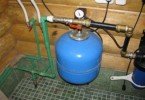May has come. So, all of us can be safely congratulated on the opening of the summer season. However, a heavy fly in the ointment inevitably relies on each barrel of honey. And the next spring appearance in the well of muddy water may well qualify for this little respect. Want to know how to purify water in a well yourself without extra money and validol? Read on. We promise it will be interesting.
Content
- How to purify water in a well – useful tips from our experts
- How to pump water from a well
- Cleaning and arrangement of the bottom of the well
- Well disinfection
How to purify water in a well – useful tips from our experts
Every spring, happy owners of summer cottages face the same problem – how to clean the water in the well after floods and snow melt. In this case, the owners of water supply can only be envied. It’s just that not all dachas have water pipelines. But even if carried out, the water supply is either irregular, or in general is carried out according to a schedule that is not always convenient for the summer resident. Therefore, even in the presence of a water supply system, a careful owner drills a well in a section or digs a well. And, if there is muddy water in the well, then the summer season must begin with its disinfection, which is performed as follows:
- the first pumping of water from the well;
- bottom cleaning and drainage arrangement;
- disinfection of the bottom and walls of the well;
- second pumping, filling the well with fresh water.
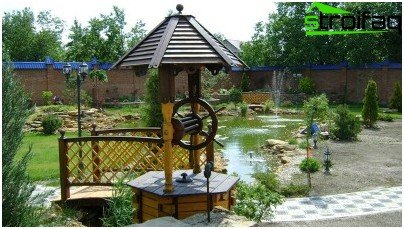
Well in a summer cottage
How to pump water from a well
Pumping water from a well is usually done with a pump or electric pump. It is convenient to use submersible electric pumps with a top water intake of domestic production, for example, “Trickle” or “Kid” (there are other analogues). They are easy to use and have a sufficient height of water rise (from 25 to 40 meters). The price is 1200 – 1800 rubles, depending on power consumption, optimal performance and height of the water.
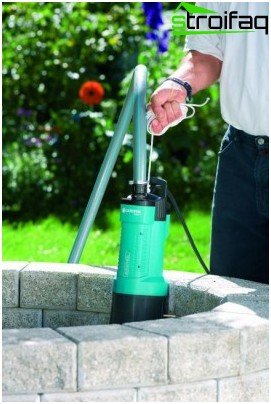
Pumping water from a well using a submersible pump
Pumping may also be necessary if there is a need to deepen the well. Anyway, you can use a submersible electric pump all summer to water directly from a well or to fill irrigation tanks.
Cleaning and arrangement of the bottom of the well
First of all, we clean the well of large debris. If stones, branches or small animals got into it, then, of course, you should immediately remove all this.
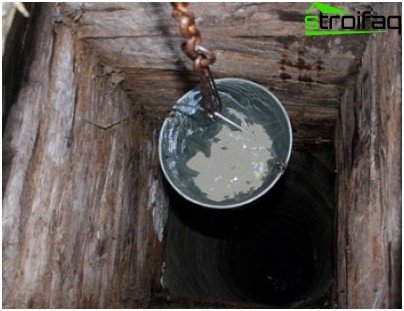
Spring polluted well
It is desirable to lay the bottom of the well with large pebbles, stone chips, but best of all with silicon. From school, we remembered silicon or flint as a stone for producing fire. But it turns out that not only is it valuable! Since ancient times, healers have used its healing properties, namely bactericidal and antiseptic. Therefore, silicon can also be used to purify water from a well. In Russia, to obtain clean, transparent and “healing” water, even the inner surface of the wells was laid out with flint. So, flint chips can be used as a filter for water from a well, which, incidentally, is used in the industrial manufacture of water filters.
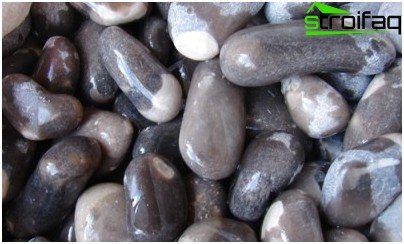
Silicon round for arrangement of the bottom of the well
The drainage gasket at the bottom is formed as follows. After cleaning, as a drainage or a filter for cleaning well water, the following minerals are laid in layers in a certain sequence:
- shungite or quartz;
- zeolite or permutite (artificial crystals of zeolite – a mineral used to purify water);
- Activated carbon.

Shungite for arrangement of the bottom of the well
This gasket should be updated every 5 years, and it is better to do it in the summer or in the fall..
Interesting facts about shungite. It is considered a healing stone. And we, the Russians, were lucky because the deposit of this mineral was found only in Karelia. It has been proven that shungite is the only rock in the world containing fullerenes (nanoparticles of carbon origin). Using fullerenes, French experts searching for tools that help slow down the aging process and prolong life, in the course of their research, achieved an increase in the life expectancy of animals by half. When interacting with water, shugnite releases the fullerene therapeutic complexes into it. Water treated with shungite in a certain way heals wounds and burns, allergic and skin diseases, diabetes and oral diseases, and is also successfully used in cosmetology.
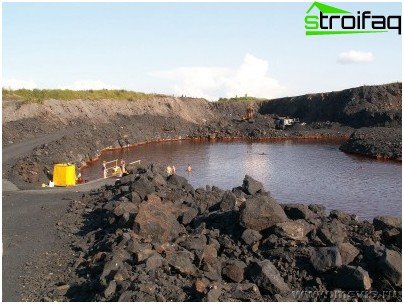
Shungite deposit
It is not always possible to purchase shungite and zeolite in sufficient quantities to equip drainage. In this case, stock up with at least a small amount of these miracle stones. If you put them on the bottom, for example, of a three-liter jar, and pour water from your well into it, then after 30 minutes the water will be cleaned and you can drink it.
Well disinfection
After the water is pumped out and it will be purified, we carry out disinfection. Here’s how it looks step by step.
- Step number 1. The bottom of the well must be filled with bleach. Chrompeak or similar chlorine-containing substances can be used instead of bleach..
- Step number 2. Leave on for 2-3 days. During this time, the well will be filled with new water, and chlorine, which is a volatile substance, will completely evaporate, leaving no trace. But during its action all pathogenic bacteria will be destroyed.
- Step number 3. After disinfection, you need to perform a second pumping of water. Now the well will be cleaned for sure!
Important! How to calculate the amount of bleach for disinfection? A bleach solution is prepared at the rate of 20-25 mg of bleach per 1 liter of water. When disinfected with pure chlorine, it will need five times less. Calculate the amount of water in the well based on the diameter of the well and the height of the water that is in the well. It is easy to guess that both of these numbers (in meters) should be multiplied. It is also recommended to process the walls of the well. They can be whitened with lime mortar or just sprinkled with a dry lime.
If there is a threat of an epidemic of intestinal diseases, it is recommended to carry out disinfection of water in the well with bleach every day. A chlorine solution in this case is prepared with a reduced concentration of about fifty times, which will be 2-5 mg per liter of water.
How to make a well water analysis
The quality of well water depends on which aquifer it is derived from. Deep layers of groundwater are generally cleaner. And groundwater and water formed after snow melt and containing various harmful impurities can fall into the upper aquifer. We will not delve into geology. We are more interested in chemistry and biology.
A story from childhood. In the good old days, in a village in central Russia, the water of a woman was carried on a yoke from a well. It was not just a well – it was a temple of clean water. A log cabin rose above the well, and a wooden scoop floated on the edge. You could drink directly by scooping up icy water. She was cold and tasty even at the height of summer! Surely, someone else remembers that taste of childhood still!
Nowadays, even after a thorough disinfection and installation of natural filter pads, water from summer cottages can only be used for technical needs: watering beds, washing facades, washing clothes, etc..
To drink this water, you need to use additional filters to purify water for the well, since there are a lot of them with various degrees of purification now available. It is best to choose the “right” filter, taking into account the chemical composition of the water, then the water from your well will become not only harmless, but can also become healing. Chemical and bacteriological analysis of well water should be done in specialized laboratories.
A bacteriological analysis of water costs from five hundred to eight hundred rubles. The estimated cost of chemical analysis is from $ 20 to $ 30 and depends on the list of indicators studied, which includes:
- indicators of acidity, alkalinity, salinity;
- stiffness, oxidizability, color, turbidity and smell of water;
- mineral composition – manganese, iron, nitrates, phosphates, nitrogen.
For analysis, you need to collect at least one and a half liters of water. Rinse the bottle first with the same water..

Chemical analysis of water in the laboratory
Knowing the chemical parameters, it is possible to perform additional purification of water from excess minerals or, conversely, enrichment of water with missing minerals. For example, there are cases when, in certain areas with a certain water composition, people massively acquire some types of diseases, which, in fact, could have been avoided by simply filtering the water.
Horror stories about exceeding the chemical composition of water
- The increased iron content in water colors the water a reddish-brownish color. Not only does it worsen the taste of water, it also adversely affects the skin, contributes to allergic diseases, and also can affect the blood morphology.
- Elevated levels of manganese in water can have a mutagenic effect on humans. The manifestation of an increased content of manganese can be noticed by a specific taste, as well as by brown spots that appear on clothes when washing.
- Lime water leads to the appearance of gout, which manifests itself in the form of deposition of salts in the joints, as well as kidney stones, expressed in the form of deposition of salts in the kidneys.
- Sulfides cause irritation of the skin, having a toxic effect on humans. And hydrogen sulfide is poison for all living things.!
The above horror stories suggest that additional purification of water from a well using specially selected water filters from a well selected according to the results of biochemical analyzes can save you from various unpleasant sores. And, therefore, the question of whether or not to analyze the water from our country well should be decided in favor of “DO!”.
Follow our recommendations. Write in the comments your “recipes” for cleaning well water. And be healthy!





